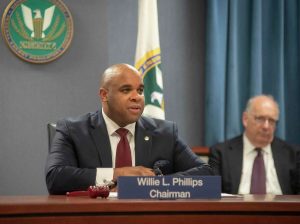
The Federal Energy Regulatory Commission acted Monday to ensure the transmission grid can meet the nation’s growing demand for reliable electricity with a new rule that outlines how to plan and pay for facilities that regions of the country will need to keep the lights on and power the American economy through the 21st Century.
It was immediately criticized by one U.S. Senator who said consumers will face higher charges and is another example of the Biden administration’s obsession with green energy.
The rule, Order No. 1920, marks the first time in more than a decade that FERC has addressed regional transmission policy – and the first time the Commission has ever squarely addressed the need for long-term transmission planning.
“Our country is facing an unprecedented surge in demand for affordable electricity while confronting extreme weather threats to the reliability of our grid and trying to stay one step ahead of the massive technological changes we are seeing in our society,” FERC Chairman Willie Phillips said.

“Our nation needs a new foundation to get badly needed new transmission planned, paid for and built. With this new rule, that starts today.”
The grid rule adopts specific requirements for transmission providers to conduct long-term planning for regional transmission facilities and determine how to pay for them. It reflects tens of thousands of pages of comments, filed over the course of the past three years, from hundreds of stakeholders representing all sectors of the electric power industry, advocacy groups and state and other government entities.
The rule requires transmission operators to conduct and periodically update long-term transmission planning over a 20-year time horizon to anticipate future needs. It also provides for cost-effective expansion of transmission that is being replaced, when needed, known as “right-sizing” transmission facilities. And it expressly provides for the states’ pivotal role throughout the process of planning, selecting, and determining how to pay for transmission lines.
“We need to seize this moment,” Chairman Phillips said. “Over the last dozen years, FERC has worked on five after-action reports on lessons learned from extreme weather events that caused outages that cost hundreds of lives and millions of dollars. We must get beyond these after-action reports and start planning to maintain a reliable grid that powers our entire way of life. The grid cannot wait. Our communities cannot wait. Our nation cannot wait.”
Wyoming U.S. Sen. John Barrasso, the ranking member of the Senate Committee on Energy and Natural Resources, said the rules will mean higher costs for consumers.
““FERC’s partisan vote today is bad news for American families and does nothing to improve electric reliability. Since President Biden took office, retail electricity prices have increased 29 percent. Based on FERC’s meeting, the Commission’s rule will only add to those costs,” said the Senator.
“Today’s decision will force customers – often in rural states – to pay for new transmission lines even when those lines don’t provide any meaningful benefit to them. It is the holy grail for liberal politicians in California and New York and corporate executives who want others to foot the bill for their climate obsession.”
Order No. 1920: FERC Takes on Long-Term Planning with Historic Grid Expansion Rule
Brief Summary: Order No. 1920 The Grid Expansion Rule adopts specific requirements for transmission providers to conduct long-term planning for regional transmission facilities and determine how to pay for them. It reflects tens of thousands of pages of comments, filed over the course of the past three years, from hundreds of stakeholders representing all sectors of the electric power industry, advocacy groups and state and other government entities. The rule requires transmission operators to conduct and periodically update long-term transmission planning over a 20-year time horizon to anticipate future needs. It also provides for cost-effective expansion of transmission that is being replaced, when needed, known as “right-sizing” transmission facilities. And it expressly provides for the states’ pivotal role throughout the process of planning, selecting, and determining how to pay for transmission lines.
Order No. 1977: FERC Unanimously Approves Backstop Transmission Siting Procedures
Brief Summary: Order No. 1977 updates the process to be used in the limited circumstances when the Commission is called upon to exercise its siting authority. Order No. 1977 includes a Landowner Bill of Rights, codifies an Applicant Code of Conduct as one way for applicants to demonstrate good-faith efforts to engage with landowners in the permitting process, and directs applicants to develop engagement plans for outreach to environmental justice communities and Tribes. Importantly, the rule does not adopt the proposal to allow simultaneous processing of state and FERC siting applications.
A more detailed summary is available here: https://www.ferc.gov/news-events/news/ferc-unanimously-approves-backstop-transmission-siting-procedures
Staff presentation: https://www.ferc.gov/news-events/news/staff-presentation-applications-permits-site-interstate-electric-transmission



